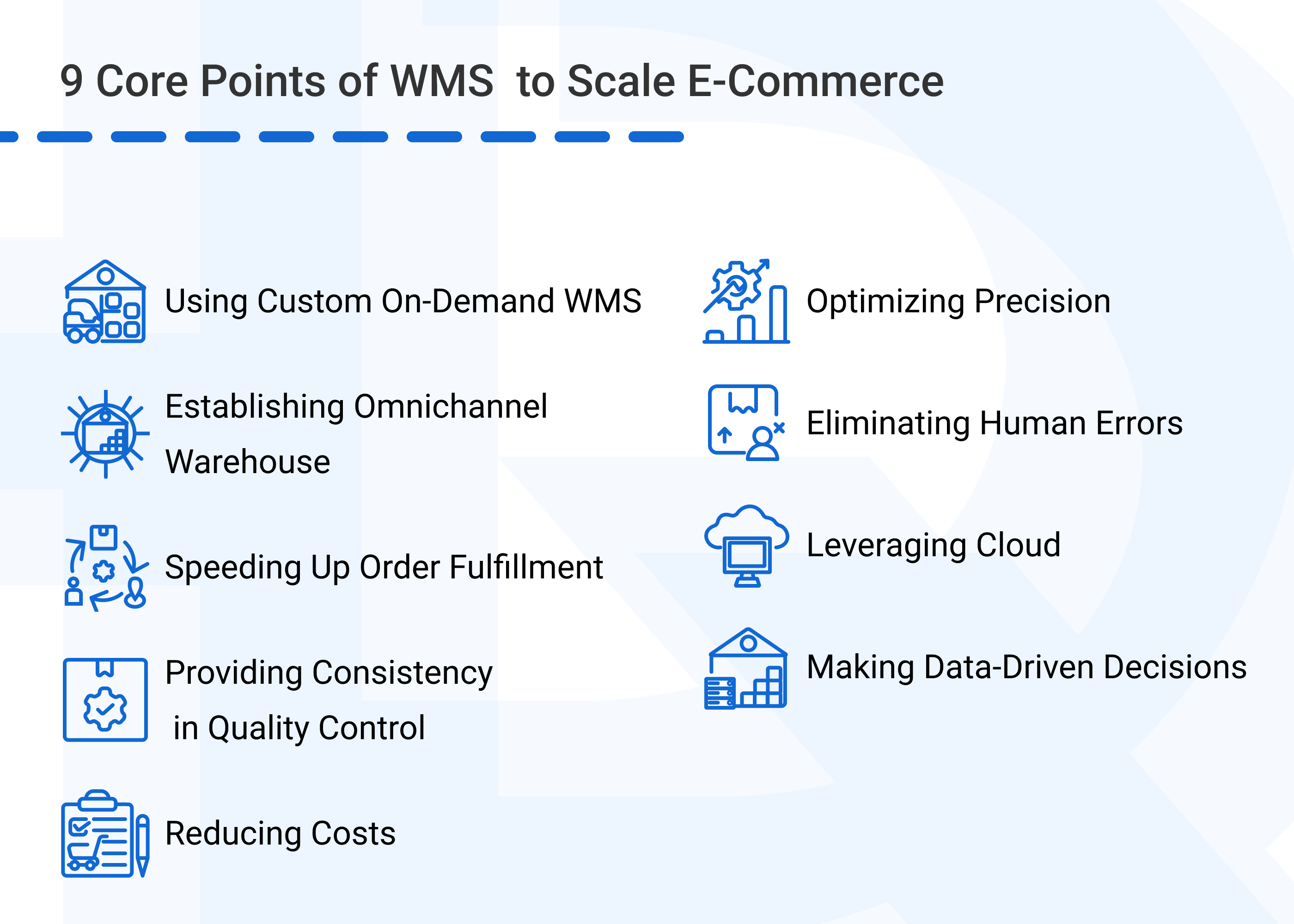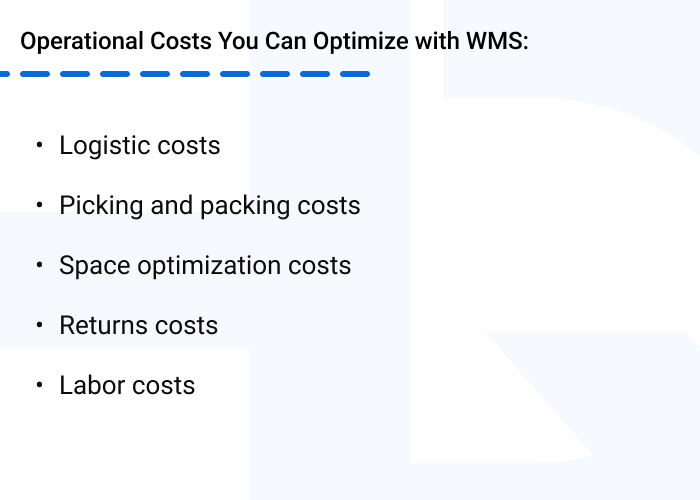What is an E-Commerce Warehouse Management System?
Differences Between an E-Commerce Platform and a WMS
E-commerce businesses can scale their scalable operations using a warehouse management system that will help automate the tasks involved in shipping, fulfillment and storage, display a clear picture of their inventory, and provide reports that help them optimize weak areas. By implementing a warehouse management system (WMS), they can streamline warehouse operations and free up their time to focus on more important things.
In this article, we will examine what e-commerce warehousing is and how to scale your operations using WMS.
What is an E-Commerce Warehouse Management System?
Differences Between an E-Commerce Platform and a WMS
An e-commerce Warehouse Management System (e-commerce WMS) is a tool that allows online businesses to manage orders, inventory, and delivery operations all in one place. Warehouse Management System development main goal is to facilitate day-to-day warehouse operations and provide real-time visibility into inventory levels, product locations, and order statuses.
A warehouse management system automates the majority of time-consuming manual processes, such as receiving and storing inventory, picking and packaging orders, and shipping products. As a result, the technology lowers the likelihood of human mistakes while increasing the efficiency of your warehouse operations. Below are listed the key tasks of an e-commerce WMS:
A WMS and an e-commerce platform serve distinct purposes in the context of online shopping. The primary aim of an e-commerce platform is to make it easier to buy and sell products or services online, whereas a WMS manages the logistical aspects of maintaining inventories inside a warehouse. You can find more differences in the table below.
| Criteria | E-Commerce Platform | WMS |
| Focus | manages online stores, enabling businesses to sell products or services via the Internet | manages and optimizes overall warehouse operations |
| Functionality | provides features for website design, product catalog management, shopping cart functionality, payment processing, and customer checkout | handles key warehouse functions such as receiving, delivery, inventory tracking, order picking, packing, shipping, and returns processing |
| Benefits | prioritizes creating a user-friendly online shopping experience, including product searching, reviews, personalized recommendations, and customer account management | automates routine tasks, provides real-time visibility into inventory levels, locations, and stock movements, optimizes stock accuracy, minimizing out-of-stock events and reducing carrying costs |
| Integration | advertising platforms and other marketing tools, CRM systems, accounting software | e-commerce platforms, transportation management systems (TMS), enterprise resource planning (ERP) systems |
| Data analytics | provides reporting and analytics capabilities to track sales, customer behavior, conversion rates, etc. | provides real-time visibility into inventory levels, trends, and patterns, making it possible to forecast demand and optimize inventory levels to prevent overstocking or running out of stock |
A warehouse logistics system for e-commerce has three primary characteristics: a wide range of stored SKUs (stock keeping units), a large number of customers, and the need to process many orders at once. It concentrates on controlling the actual movement of goods through a warehouse, from receiving to shipment. This calls for keeping tabs on inventory levels, planning order fulfillment, controlling stock availability, and making the most of available storage.
Need to develop a custom WMS to scale your e-commerce operations?HQSoftware has a team of skilled professionals ready to tackle the project. Let’s talk!
Anna Halias
Business Development Manager
A well-thought-out e-commerce WMS will help scale your business by tracking inventory levels and coordinating deliveries across different channels. The system can streamline your supply chain and reduce processing time for orders, saving you time and money. A comprehensive e-commerce WMS can also help you:
We’ve highlighted nine core points of WMS to scale e-commerce that you should be aware of.

With custom software development, you can adapt your WMS system to the specific needs of your online business. This means you can select the features that are most important to you and scale your warehouse management system as your company grows.
With a custom WMS, you can expect enhanced productivity, improved accuracy, and seamless scalability of your operations.
Improved accuracy and faster order fulfillment are major advantages of adopting a warehouse management system for your e-commerce operations.
A WMS for e-commerce is built in such a way that employees can complete the buyer’s order in a short time, collect orders into a delivery route, and ship the goods. In some cases, less than one hour may pass from the moment the order is received at the warehouse until it is shipped to the destination.
The system generates digital picking lists with customer information, order numbers, dates, and locations, SKUs, and shipping routes for the items to be picked. In this way, the system monitors the status of each order and changes inventory levels in real time, giving management and customers reliable information. Below we provide the two most efficient order picking strategies.
Single-item picking. Using this technique, a warehouse worker picks out a single item and takes it from one spot in the warehouse to a shipping area. The WMS ensures that the item is accurately recorded and accounted for, while directing an employee along the most effective route.
Cluster picking. Within this method, orders are sorted into groups, called clusters, based on factors such as same product category, item location, or order priority. To help the picker effectively reach the specified clusters and collect the required products, the software system will create a map of the warehouse and give assistance and instructions. This technique makes picking operations more productive, resulting in shorter picking times, higher output, and lower error rates.
With a WMS for e-commerce, you may optimize warehouse space, making it easier to locate goods and complete orders promptly. Using automated storage and retrieval systems (ASRS), WMS calculates the amount of floor space needed for storage, depending on its parameters.
The system can also identify products in high demand, as well as temporary or seasonal goods, and offer the most effective storage locations so workers will be able to reach items easily. For instance, big and bulky boxes should be placed lower on the shelves, making it easier for warehouse cars to pick them up when they arrive. The system makes it possible to both maximize the use of available space and accelerate order picking.
By implementing an e-commerce WMS, you can provide a seamless customer experience across various communication channels, such as online shops, brick-and-mortar stores, and distribution centers. For example, customers can place orders online and pick them up in-store.
An omnichannel WMS provides a unified interface for several platforms, so you can manage orders centrally and without confusion. At the same time, it provides users with an accurate and real-time view of inventory levels, orders, and shipments across all those channels.
With a WMS, you can boost the efficiency of quality control operations. For example, the system can monitor product expiration dates and alert you when they’re approaching, to minimize loss.
As well, a WMS improves quality audits. For instance, the system can compile a daily list of objects that need to be checked according to certain parameters such as cost, expiration date, material, and so on. Thus, the worker can verify the quality of a single item by using a mobile app.
We developed such a feature for one of our clients. This helped deliver accurate data, decreasing the likelihood of errors in other warehouse activities.
Quality checks can be performed at various stages of the supply chain, from inbound to outbound, improving the overall quality of the product.
Since a WMS automates many daily operations, it reduces errors in product selection and order picking. You can follow the movement of products in real-time by using barcodes and radio frequency identification (RFID) technology. If you scan the wrong barcode, the system quickly notifies the user that the incorrect goods were scanned. In this way, you can be sure that the correct products are delivered to the correct clients.
A cloud-based WMS allows you to see your inventory in real-time from any device, enabling remote management of warehouse operations. It operates 24/7 from any device via browser and doesn’t require software installation and regular updates, as the vendor handles them on its side.
Such systems work in a flexible environment and offer increased processing capability. Thus, delays in system operation are less severe, and the likelihood of declining to purchase items is lower. As well, cloud-based solutions provide a high level of cybersecurity, which is critical for any e-commerce business.
An e-commerce WMS helps you make informed decisions about managing your inventories, completing orders, and overall operations, by leveraging collected data.
Using predictive analytics, you can forecast customer demand and calculate the required quantity of items, predict consumer behavior, enable price adjustment, and identify fraud. This is accomplished by examining previous purchase histories, statistics, client reviews, internet activity data, and more.
WMS data is also useful for marketing and sales departments, allowing them to set a smart price, create proper advertising, and promote products by examining data from sales, returns, and customer feedback.
In addition, data-driven decisions aid in the identification of inefficiencies in warehouse operations. For example, you can discover bottlenecks and streamline the fulfillment process by measuring the time it takes to pick and pack orders.
While e-commerce businesses have many advantages, one of the biggest challenges they face is reducing operational costs. To paint a better picture, we can suggest 5 ways using a WMS can help you cut e-commerce operations.

WMS automates time-consuming warehouse processes such as inventory tracking, order picking, and shipping. Implementing the technology optimizes shipment routes and lowers transportation expenses.
Packaging optimization minimizes package size and weight, which can also result in significant savings in shipping expenses. This can improve the consumer experience by ensuring that products arrive in good condition with minimal packing waste. It is especially critical for fragile and oversized items.
Implementing lean inventory management rules and data analytics optimizes warehouse layout and product placement. For example, the system can provide you with appropriate packing and storage alternatives that will maximize space utilization and decrease costs.
WMS software can significantly streamline returns and exchanges by automating return tasks such as issuing refunds and restocking returned items. The system provides real-time visibility into inventory levels and assists in identifying slow-moving or broken goods that might need to be taken off the shelves in order to reduce the number of returns.
A WMS enables you to create a map of your warehouse and choose the best path for selecting and packing items. This can shorten the amount of employee time needed to fulfill orders, which results in lower labor costs.
Also, you can organize and assign responsibilities to your employees using a WMS. This allows for checking the progress of any particular task to see what the workers have already completed. It’s simple to determine where a mistake was made because of this control’s clarity and visibility.
By scaling your warehouse management system, you can optimize everyday inventory and order fulfillment operations while focusing on sales growth. To ensure that your company genuinely benefits from the e-commerce warehouse management system, it is critical to employ the best strategies to implement WMS into your warehouse.
WMS implementation positively impacts the economic performance of e-commerce businesses. Well-coordinated work of an online store leads to customer satisfaction, encourages clients to come back, leads to positive reviews, and increases brand awareness on the market.
Operating an e-commerce warehouse using a WMS developed by HQSoftware will benefit you in:
At HQSoftware, we create individual WMS solutions that are fully integrated with the required online store and adapted to the specific needs of your enterprise. If you are looking for a customized WMS solution, please do not hesitate to contact us. Our highly qualified experts are ready to handle your request to determine the optimal system and fulfill your business goals.

Head of Production
To ensure the outstanding quality of HQSoftware’s solutions and services, I took the position of Head of Production and manager of the Quality Assurance department. Turn to me with any questions regarding our tech expertise.
We are open to seeing your business needs and determining the best solution. Complete this form, and receive a free personalized proposal from your dedicated manager.

Sergei Vardomatski
Founder